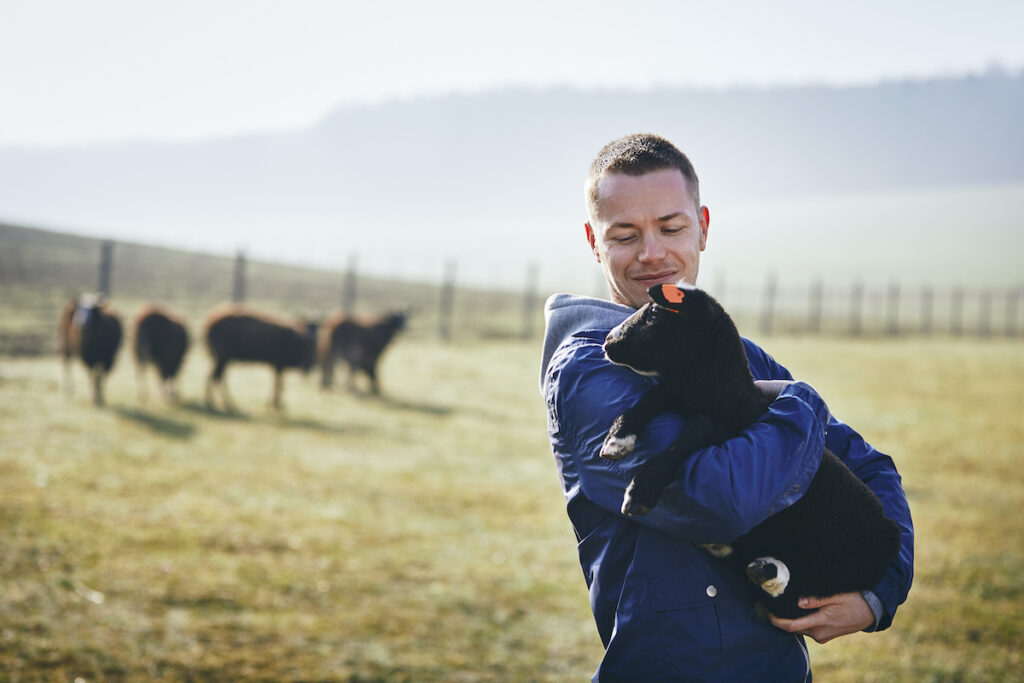
One in four adults experiences a mental health problem annually, costing the economy almost £105 billion (MHFA England, 2021). Mixed anxiety and depression have been estimated to cause one fifth of days lost from work in Britain (Mental Health Foundation, 2019). This highlights the need to transform the care of those with mental illness, both within and beyond the NHS. Social prescribing is being advocated by several national organisations as a psychosocial, individualised approach to caring for people’s physical and mental health.
Care farming is one such socially prescribed intervention. Care farming is the therapeutic use of farming practices (Parsons, Wilcox, & Hine, 2010). It can involve various farming activities varying from livestock to forestry. Evidence suggests that natural environments may promote physical activity, support social contact, reduce stress and improve the immune response (Thompson et al, 2019). Environmental activities with hands-on engagement also allow individuals to develop skills at their own pace (O’Brien, 2011).
Some European countries have embraced these types of interventions, but the UK currently lags behind. This systematic review aimed to explore the effect of care farming on the quality of life, depression and anxiety on different population groups. The authors also aimed to create a theoretical framework to explain the mechanisms of these outcomes.

Social prescribing is a holistic approach to treating people’s mental and physical health. Care farming, the therapeutic use of farming practices, is one example of an activity that can be “prescribed”.
Methods
Twenty-two databases were searched in 2015. Grey literature and websites were also included. This was supplemented by hand searching of Wageningen Journal of Life Sciences (2000-2015) and contacting academic networks. The search of the databases was repeated in 2017. The study adhered to PRISMA guidelines. Search terms were kept broad to help identify various agriculture-based therapeutic interventions. Qualitative and quantitative research was included. Studies were screened on their eligibility and additionally screened for theories on care farming to help inform the author’s theoretical framework to explore the mechanisms of care farming. Two reviewers independently assessed the risk of bias in the included studies using various criteria.
Results
1,659 articles were identified in the first search in 2015. The rerun of the search in 2017 further identified 391 papers. Eighteen qualitative studies and 13 qualitative studies, one of which was a mixed-methods study, met the eligibility criteria. Studies included approximately 980 participants from a range of client groups, with the largest group being those with mental health problems.
Mechanisms of change
Four logical models were created from the qualitative studies to explain how care farming might work: one for all populations; one for people with either mental health or substance misuse problems; one for disaffected youth; one for people with learning disabilities. These models were made from:
- Five theoretical concepts; positive effects of nature, being socially connected, personal growth, physical wellbeing, mental wellbeing.
- Five categories of intervention (being in a group, the farmer, the work, the animals, the setting).
- Fifteen categories of mechanisms derived from the qualitative studies (achievement and satisfaction, belonging and non-judgement, creating a new identity, distraction, feeling valued and respected, feeling safe, learning skills, meaningfulness, nurturing, physical wellbeing, reflection, social relationships, stimulation, structure and understanding the self).
Primary outcomes suggested by these theories included anxiety, depression and quality of life. Proximal outcomes include confidence, stress, coping, self-efficacy and prosocial behaviours.
Effects of care farming interventions
Mechanisms seemed to differ according to the user group suggesting care farming may work differently according to the users’ needs. For example, for the disaffected youth group, “feeling safe” and “reflection” was more frequently reported than the other population groups, whereas “achievement and satisfaction” were reported less. Only the logic model for mental illness and substance misuse was tested due to a lack of quantitative data for the other groups. Whilst there was some evidence that care farms can improve self-efficacy, self-esteem and mood for this user group, there was a lack of evidence to indicate that care farms improve quality of life and limited evidence that they improve depression and anxiety.

This systematic review found some evidence that care farms improve self-efficacy, self-esteem and mood for service users with mental illness and substance misuse. Different population groups also reported different effects.
Conclusions
The authors concluded that:
there is a lack of evidence available to determine whether or not care farming is effective in improving quality of life, depression and anxiety.
A lack of robust evidence further hampered the ability to draw firm conclusions.

There is a lack of robust research into the effects of care farming in improving quality of life, depression and anxiety, therefore we can’t draw firm conclusions.
Strengths and limitations
In terms of strengths, the review included a large number of databases that included health, social care and criminal justice. This and the inclusion of grey literature helped to ensure minimal data was missed. I believe that another strength is the development of logical models to try to explain the mechanisms of the intervention, rather than simply exploring the outcomes. This allows future research to have a basis for evaluations and hopefully will improve the evidence-base into care farming.
The authors themselves pointed out several limitations, with the available evidence falling victim to small samples, poor designs, mixed user groups and unvalidated outcome measures. One of the main issues with the intervention reviewed in the paper is that care farming is very loosely defined and includes multiple activities that each may have their own effect. This is further demonstrated by the fact the authors identified 85 intervention components, which was then narrowed down to 5 categories. This makes it challenging to disentangle the effects of each component and/or how they interact. It may be only the interaction with animals is necessary to gain positive outcomes, or the service-user may feel the most benefits from the physical work.
This paper is incredibly thorough in the author’s explanation of how the logical models were created. However, because of that, it feels the focus of the review moved away from exploring the impact of care farming as an intervention and more into the creation of these models. I personally found it difficult to unpick from the results what the outcomes of the intervention actually were. As a reader interested in social prescribing and alternative, community-based interventions, I feel the paper would benefit from a clearer summary of the outcomes of care farming for different population groups.

Care farming as an intervention is very loosely defined, thus it is very difficult to untangle the effects of the different activities.
Implications for practice
In my role as a case worker for a charity, I have gained a deeper understanding of the importance of community provisions for service users and the need for alternatives to the medical model, traditional healthcare and therapy on a daily basis. Social prescribing is a trend that is only growing in popularity. Interventions such as care farming may prove to be a cost-effective alternative with positive outcomes for service-users. It is therefore crucial a more robust evidence base is established to help persuade commissioners and funders.
Statutory services are already overstretched, and this is most likely only going to increase following the Covid-19 pandemic. We need to be creative and have an open mind about how we can treat and support different population groups. Social and cultural factors need to be considered when we explore treatment options. Care farming is one such way in which we can start to think outside the box in how we care for our more vulnerable members of society.

Social prescribing is a trend that is only growing in popularity. Through this, we can start to think creatively about how we treat and support different social and cultural groups.
Statement of interests
None.
Links
Primary paper
Murray, J., Wickramasekera, N., Elings, M., Bragg, R., Brennan, C., Richardson, Z., … & Elsey, H. (2019). The impact of care farms on quality of life, depression and anxiety among different population groups: A systematic review. Campbell Systematic Reviews, 15(4), e1061.
Other references
Dayson, C., & Bashir, N. (2014). The social and economic impact of the Rotherham Social Prescribing Pilot: main evaluation report.
Mental Health Foundation (2019). Mental health statistics: the most common mental health problems. Retrieved from: https://www.mentalhealth.org.uk/statistics/mental-health-statistics-most-common-mental-health-problems [Accessed 13 April 2021]
Mental health statistics. Retrieved from: https://mhfaengland.org/mhfa-centre/research-and-evaluation/mental-health-statistics/, [Accessed 13 April 2021]
NICE (2011). Common mental health disorders | Guidance and guidelines | NICE. [online] Available at: http://www.nice.org.uk/guidance/cg123 [Accessed 13 April 2021].
Parsons, S., Wilcox, D., & Hine, R. (2010, July). What care farming is. In 9th European IFSA Symposium, 7 July 2010.
Ward Thompson C, Silveirinha de Oliveira E, Tilley S, Elizalde A, Botha W, Briggs A, et al.Health impacts of environmental and social interventions designed to increase deprived communities’ access to urban woodlands: a mixed-methods study. Public Health Res 2019;7(2)
Photo credits
- Photo by Tim Mossholder on Unsplash
- Photo by Zoe Schaeffer on Unsplash
- Photo by Matt Palmer on Unsplash
